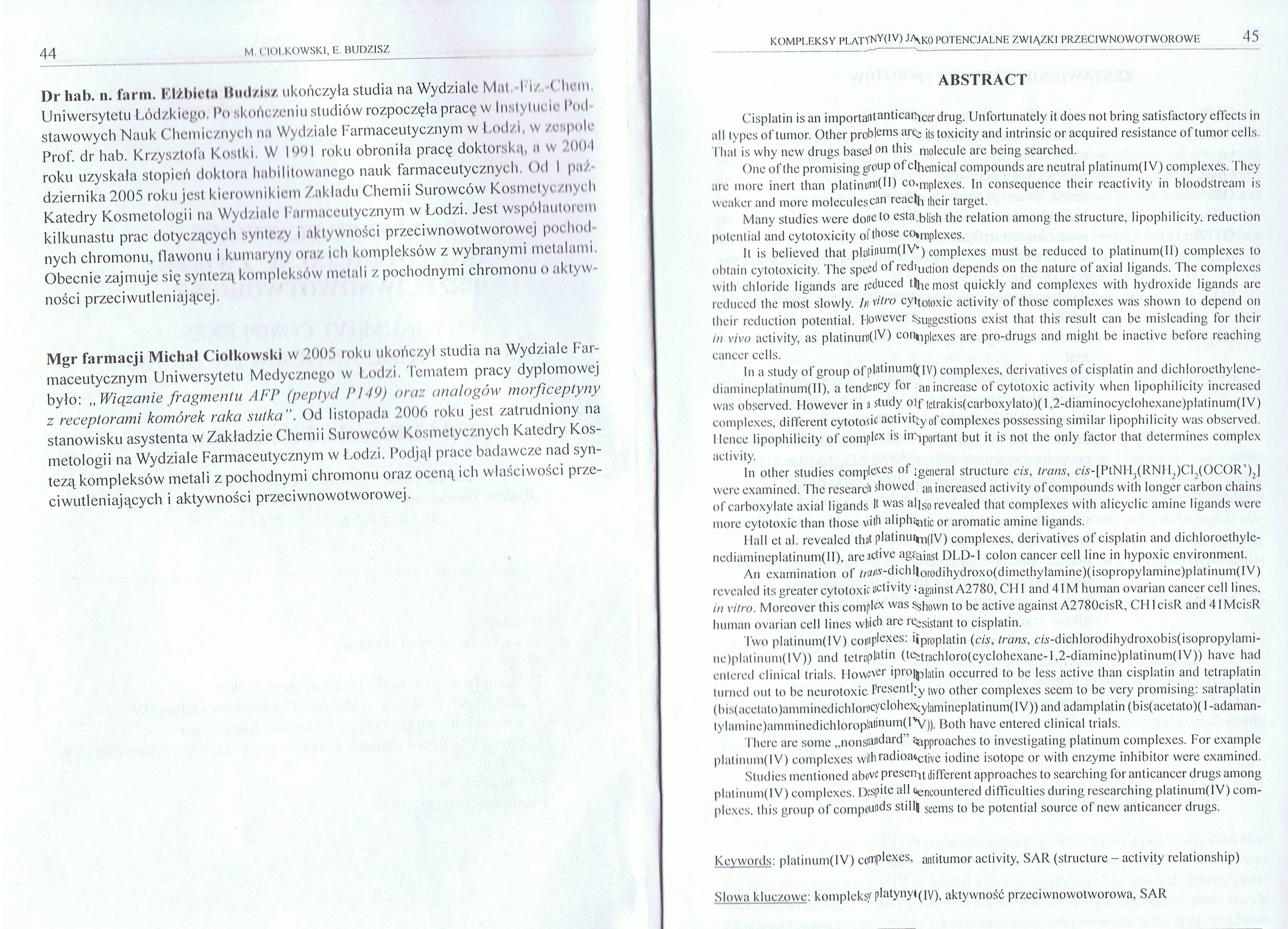CCF20090327�014

44 M CIOŁKOWSKI, E. BUDZISZ
Dr hab. n. farm. Ilżbietu Iłud/is/ ukończyła studia na Wydziale Mul. I''i/, ( lum Uniwersytetu Łódzkiego. Po skończeniu studiów rozpoczęła pracę w Instytucie Pod stawowych Nauk Chemicznych na Wydziale Farmaceutycznym w Łodzi, w zespole Prof. dr hab. Krzysztofa Kostki. W 1991 roku obroniła pracę doktorską, a w 2004 roku uzyskała stopień doktora habilitowanego nauk farmaceutycznych. Od I paź dziernika 2005 roku jest kierownikiem Zakładu Chemii Surowców Kosmetycznych Katedry Kosmetologii na Wydziale Farmaceutycznym w Łodzi. Jest współautorem kilkunastu prac dotyczących syntezy i aktywności przeciwnowotworowej pochodnych chromonu, flawonu i kumaryny oraz ich kompleksów z wybranymi metalami. Obecnie zajmuje się syntezą kompleksów metali z. pochodnymi chromonu o aktywności przeciwutleniającej.
Mgr farmacji Michał Ciołkowski w 2005 roku ukończył studia na Wydziale Farmaceutycznym Uniwersytetu Medycznego w Łodzi, lematem pracy dyplomowej było: „Wiązanie fragmentu AFP (peptyd PI 49) ora:: analogów morficeptyny z receptorami komórek raka sutka". Od listopada 2006 roku jest zatrudniony na stanowisku asystenta w Zakładzie Chemii Surowców Kosmetycznych Katedry Kosmetologii na Wydziale Farmaceutycznym w Łodzi. Podjął prace badawcze nad syntezą kompleksów metali z pochodnymi chromonu oraz oceną ich właściwości prze-ciwutleniających i aktywności przeciwnowotworowej.
ABSTRACT
Cisplatin is an importantanticaihcer drug. Unfortunately it does not bring satisfactory effects in nil lypes oftumor. Other probfcrns ar^; j|S toxicily and intrinsic or acąuired resistance oftumor cells. Tlial is why new drugs basetl on this niolecule are being searched.
Oneofthe promising group of cI|1emjCal compounds areneutral platinum(IV) complexes. They aro morę inert than platinurn(H) co'mplexes. In consequence their reactivity in bloodstream is weaker and morę moleculescim reacl)-, their’ target.
Many studies were done t° esta^lish the relation among the structure, lipophilicity. reduction potential and eytotoxicity of those co*mpiexes.
It is believed that plalii'11111!!^) complexes must be reduced to platinum(II) complexes to obtain cytotoxicity. The spectl of rediUC)j0n depends on the naturę of axial ligands. The oomplexcs witli chloride ligands are rcduccd tf)lc most quickly and compIexes with hydroxide ligands are reduced the most slowly. In vitro cytt0ioxic activity of those complexes was shown to depend on their reduction potential. Ho'vever SsUggostions exist that this result can be misleading for their in vivo activity, as platiniinifPO con»tplexes are pro-drugs and might be inactivc before reaching cancor cel Is.
In a study of group of platinumOf j y) complexes, derivatives of cisplatin and dichloroethylene-diaminoplatinum(II), a tendry for an inerease of cytotoxic activity when lipophilicity inereased was observed. However in a study off tetrakis(carboxylato)(l,2-diaminocycIohexane)platinum(IV) complexes, different cytotosic activitty0f complexes possessing similar lipophilicity was observed. I lence lipophilicity of complex is i|riportant but it is not the only factor that determines complcx activity.
In other studies complexes of jgeneral structure cis, trans, c/.v-[PtNM.(RNI i,)CI,(OCOR’)2] were examined. The researcli showed an inereased activity of compounds with longer carbon chains of carboxylate axial ligands It was al)sorevealed that complexes with alicyclic aminę ligands were morę cytotoxic than those with aliphtjuic or aromatic aminę ligands.
Hall et al. revealed that platinur|11(|V) complexes, derivatives of cisplatin and dichloroethyle-nediamineplatinum(II), areactive agą^nst DLD-1 colon cancer celi linę in hypoxic environment.
A11 examination of //śWi-dichl|orodihydroxo(dimethyIamine)(isopropylamine)platinum(IV) revealed ils greater cytotoxic activity iagainst A2780, CHI and 41M human ovarian cancer celi lines, in vitro. Moreover this complc* was %hown to be active against A2780cisR, CH I cisR and 41 McisR human ovarian celi lines wliich are r^sistant to cisplatin.
Iwo pIatinum(IV) coinplexes: ijproplatin (cis, trans, c«-dichlorodihydroxobis(isopropylami-ne)plalinum(IV)) and tetrapWht (tełtrachloro(cyclohexane-1,2-diamine)platinum(IV)) have had enlered clinical trials. Howcver iproijjiatin occurred to be less active than cisplatin and tetraplatin turned out to be ncurotoxic. Fresenthy iwo other complexes seem to be very promising: satraplatin (bis(acelato)amminedichlorocyclohex<y|amineplatinum(IV)) and adamplatin (bis(acetato)(l-adaman-tylaminelamminedichloroplatinumflA/)). Both havc entered clinical trials.
There are some „nonsiaiidard" Ąapproaches to investigating platinum complexes. For example platinum(IV) complexes withradioancthe iodine isotope or with enzyme inhibitor were examined.
Studies mentioned abov« presertit different approaches to searching for anticancer drugs among platinumflV) complexes. Despite all Hencountered difficulties during researching platinum(IV) com-plexes. this group of compounds stillj seems to be potential source of new anticancer drugs.
Keywords: plalinum(lV) complexes, antitumor activity, SAR (structure - activity relationship) Słowa kluczowe: kompleksy pl£ityny»(iv), aktywność przeciwnowotworowa, SAR
Wyszukiwarka
Podobne podstrony:
CCF20090327�001 734 E. BUDZISZ Dr hab. n. farm. Elżbieta Budzisz ukończyła studia na Wydziale Mat.-F
UNIWERSYTET ZIELONOGÓRSKI NR 8 (10)PROREKTOR DS. ROZWOJU Prof. dr hab. Marian Nowak (ur. 1950) ukońc
dr hab. Mirosława Bukowska, prof. GIG w 1981 r. ukończyła studia na Wydziale Nauk o Ziemi Uniwersyte
Gazeta AMG nr 10/2014Jestem misjonarzem ISO Dr hab. med. Tomasz Stefaniak ukończył studia na Wydzial
Dr Wojciech Jerzy Stępniowski urodził się w Krakowie w 1983 r.W 2002 r. ukończył studia na Wydziale
Gazeta AMG nr 3/2011 Gazeta AMG nr 3/2011 Prof. zw. dr hab. n. farm. Tadeusz Władysław Hermann jest
skanuj0001 4 Recenzent: prof. dr hab. n. farm. Renata Jachowicz (Collegium Medicum UJ) ISBN: 83-8993
skanuj0002 (Kopiowanie) BIBLIOTEKA FARMACEUTY KOMITET REDAKCYJNY Przewodniczący Prof. dr hab. farm.
CCF20090327�015 46 M. CIOŁKOWSKI, E. BUDZISZ 46 M. CIOŁKOWSKI, E.
CCF20090327�016 48 M. CIOŁKOWSKI, E. BUDZISZ aminy oraz dwie zdolne do wymiany grupy (aniony chlorko
CCF20090327�017 50 M. CIOŁKOWSKI, E. BUDZISZa) Pt(NH3)2CI4b) Pt(NH3)2CI2(OAc)2 c) Pt(NH3)2CI2(OH) Cl
CCF20090327�018 52 M. CIOŁKOWSKI, E. BUDZISZ Aktywność związków była porównywalna, zarówno w „tradyc
więcej podobnych podstron